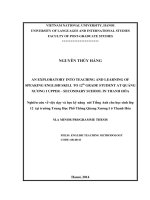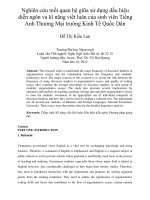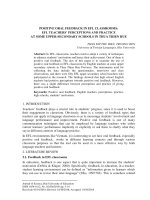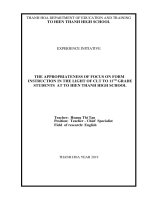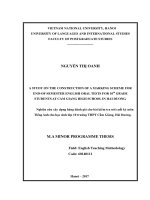An investigation into classroom interaction in teaching the english reading skill to 10th grade students at some upper secondary schools in quang tri province
Bạn đang xem bản rút gọn của tài liệu. Xem và tải ngay bản đầy đủ của tài liệu tại đây (775.25 KB, 29 trang )
MINISTRY OF EDUCATION AND TRAINING
HUE UNIVERSITY
COLLEGE OF FOREIGN LANGUAGES
------------------PHAM THI TUYET VAN
AN INVESTIGATION INTO CLASSROOM
INTERACTION IN TEACHING THE ENGLISH
READING SKILL TO 10th GRADE STUDENTS AT
SOME UPPER SECONDARY SCHOOLS
IN QUANG TRI PROVINCE
SYNOPSIS
MA THESIS IN THEORY AND METHODOLOGY
OF ENGLISH LANGUAGE TEACHING
HUE, 2013
1
MINISTRY OF EDUCATION AND TRAINING
HUE UNIVERSITY
COLLEGE OF FOREIGN LANGUAGES
------------------PHAM THI TUYET VAN
AN INVESTIGATION INTO CLASSROOM
INTERACTION IN TEACHING THE ENGLISH
READING SKILL TO 10th GRADE STUDENTS AT
SOME UPPER SECONDARY SCHOOLS
IN QUANG TRI PROVINCE
SYNOPSIS
MA THESIS IN THEORY AND METHODOLOGY
OF ENGLISH LANGUAGE TEACHING
CODE: 60140111
SUPERVISOR: NGUYEN THI QUYNH HOA, D.Ed.
HUE, 2013
2
BỘ GIÁO DỤC VÀ ĐÀO TẠO
ĐẠI HỌC HUẾ
TRƯỜNG ĐẠI HỌC NGOẠI NGỮ
-------------PHẠM THỊ TUYẾT VÂN
KHẢO SÁT SỰ TƯƠNG TÁC TRONG LỚP HỌC ĐỐI
VỚI VIỆC DẠY KỸ NĂNG ĐỌC TIẾNG ANH
CHO HỌC SINH LỚP 10 TẠI MỘT SỐ
TRƯỜNG PHỔ THÔNG Ở TỈNH QUẢNG TRỊ
TÓM TẮT LUẬN VĂN THẠC SĨ LÝ LUẬN VÀ PHƯƠNG PHÁP
DẠY HỌC BỘ MÔN TIẾNG ANH
MÃ SỐ: 60140111
NGƯỜI HƯỚNG DẪN KHOA HỌC: TS. NGUYỄN THỊ QUỲNH
HOA
Huế, 2013
3
ABSTRACT
This thesis aims to investigate effective ways to improve
students’ learning of reading skill in English classes through classroom
interactions at Quang Tri upper secondary schools. Firstly, it defines
the importance of classroom interactions. Secondly, it seeks to answer
which interaction patterns can be observed in language classroom.
Thirdly, it studies how these interactions affect the learners’
participations and learning outcomes. The participants of this study
include 20 teachers and 100 students from the 10th classes at Trung
Vuong and Quang Tri upper secondary schools. The data are collected
by means of questionnaires, class observations and interviews and then
statistically analyzed by means of charts and tables.
These findings of the research show that both teachers and
students are aware of the importance of classroom interactions. The
teachers used many types of activities to encourage students to learn
and interact with them so that they have more chance to develop the
reading skill. However, there is a mismatch between the teachers’
belief and their students’ perceptions of effect of the interaction
modes the teachers think popular they create inside their classrooms.
From the findings, there are three types of classroom interaction
including teacher- student, student- student and student- content. The
survey shows that the teacher- student and student- student
interaction modes are frequently used in teaching and learning
English reading skill at Quang Tri upper secondary schools. Finally,
4
some implications and suggestions are made with the hope that
teachers will improve the students’ English through promoting
classroom interactions.
5
CHAPTER 1- INTRODUCTION
1.1. Rationale
For non- native English speakers, English reading has been
considered as one of the necessary skills that they need to achieve. I
have discovered that students at some upper secondary schools in
Quang Tri province have encountered some difficulties in English
reading due to some factors. In reality although many students spend
a lot of time and energy learning English, they still fail to use English
to communicate effectively. Classroom interaction can be seen as an
effective way for students to learn the reading skill. It is where
students and teacher exchange their knowledge and lessons related
problems. Through interaction students have more chance to practice
the reading skill. Today with the popularity of CLT in Viet Nam,
English learners had access to a more interactive learning
environment.
On the other hand, not many students realize the importance of
interaction in their learning and of implementing those strategies
efficiently. Therefore, I am motivated to choose the topic “An
investigation into classroom interaction in teaching the English
reading skill to 10th grade students at some upper secondary schools
in Quang Tri province” for my thesis and I hope to increase the
students’ awareness of the importance of English classroom
interaction and improve the students reading abilities reading
comprehension.
6
1.2. Aims and objectives
This thesis has been carried out to investigate
classroom in interaction in teaching the English reading skill
to the 10th grade students at some upper secondary schools in
Quang Tri province so as to give some suggestions for
improving their reading skill.
1.3. Research questions
1. Which types of classroom interaction are used in teaching
the English reading skill to 10th grade students at some upper
secondary schools in Quang Tri province?
2. How do these interactions affect the learners' participation
and their learning outcomes?
3. What suggestions can be made to improve the teaching and
learning of the reading skill via classroom interaction?
1.4. Scope of the research
This research focuses on investigating classroom interaction in
teaching the English reading skill more communicatively to grade
10th grade students at some upper secondary schools in Quang Tri
province namely: Trung Vuong and Gio Linh.
1.5. Significance of the research
The result of this research will bring about some possible
solutions, meaningful suggestions and pedagogical implications
7
which are very beneficial for teachers to overcome difficulties
mentioned previously and improve English language communication
for grade 10 students through the reading skill.
1.6. Structure of the thesis
Chapter 1: Introduction
Chapter 2: Literature review and theoretical background
Chapter 3: Research methodology
Chapter 4: Findings and discussion
Chapter 5: Conclusions and implications
CHAPTER 2 - LITERATURE REVIEW AND
THEORETICAL BACKGROUND
2.1. Previous studies related to the topic
There are many researchers have considerably contributed to
the improvement of teaching and learning English reading skill to
some extent. However, the issue of applying the classroom
interaction with four skills especially the reading skill has not paid
much attention to. Therefore, I find it necessary to conduct this
research.
2.2. Interaction
2.2.1. Interaction as a general term
2.2.2. Interaction as a key term in EFL
8
2.3. Teaching and learning activities promoting interaction
2.4. Types of classroom interaction
2.4.1. Teacher – Student interaction
2.4.1.1. Teacher- Student interaction
2.4.1.2. Teacher- Students interaction
2.4.2. Student- student interaction
2.4.2.1. Student- Students interaction
2.4.2.1. Student- Student interaction
2.4.3. Student- content interaction
2.5. Definition of the reading skill
Though these opinions are not exactly the same, what comes
up as a common point is that reading skill is the process in which the
readers, as they read, can recognize the graphic forms of the reading
text and understand what is implied behind these forms. The second
definition helps to make the definition by Nunan clear and complete.
The researcher finds it good to combine Nunans (2003, p.68) and
Grabes (1991, p.378) ideas in defining reading to include in the
research. That is, the thesis will be based on the two abovementioned definitions whenever the concept is dealt with. I will base
on the definition reading of William which states that reading was a
process where by ones look at and understands what has been written
and the reader is not simply a passive object fed with letters, words
9
and sentences, but it is actively working on the text, and is able to
arrive at understanding without looking at every letter and word.
2.5.1. Stages of teaching reading
2.5.1.1. Pre-reading stage
2.5.12. While-reading stage
2.5.1.3. Post-reading stage
2.5.2. Reading in second language learning and teaching
2.5.2.1. The importance of teaching reading in the L2 classroom
2.5.2.2. Reading purposes of second language learners
(Rivers and Temperley 1978, cited in Nunan, 1989:34)
2.5.3. Students and teachers’ roles in studying and teaching the reading
skill
2.5.3.1. Students’ roles in studying the reading skill
2.5.3.2. Teachers’ roles in teaching the reading skill
2.6. Summary
This chapter so far has presented the relevant literature, which
has helped to form the theoretical and conceptual framework for the
study. It has talked about different aspects related to the reading skills
and reading activities. What is more, the importance of teaching
reading in the second language classroom and factors in teaching and
learning reading have been reviewed.
10
CHAPTER 3 - METHODOLOGY
3.1. Research methods
The research method has to be chosen suitably to clarify the
aims of the research and solve the research questions; this study
utilized the combination of appropriately qualitative and quantitative
approaches.
3.2. Participants
The research was carried out to examine the teachers’ and
students’ interactions in class at some upper secondary schools in
Quang Tri province; and therefore, the participants of the study
involved both EFL teachers and students.
3.2.1. Teachers
3.2.2. Students
3.3. Instruments for data collection
In this study, two mains tool, namely questionnaires and
interviews, have been utilized to collect data about students’
perceptions and practices in learning reading texts.
3.3.1. Questionnaire design
Questionnaires are considered as instruments to gather
information on a large scale. As usual, a questionnaire includes openended and close- ended questions. Thus in this study, the connection
of open- ended and close- ended questions is most suitable.
11
3.3.2. Interview design
+ Teachers’ interviews:
+ Student’s interviews:
3.3.3. Class observation
The class observation is used to confirm the reliability of the
results collected from questionnaires.
3.5. Data analysis
Part 1: Collecting the previous research to this research. Part 2:
Adjusting some necessary problems for questionnaire and interview
questions. Part 3: Collecting data from questionnaire and interview
questions. Part 4: Doing the arrangement analysis and showing the
collected data in the right order in parts. Part 5: Presenting the
findings and discussion. Part 6: Drawing out concluding and
implications.
3.7. Summary
The chapter presented the issues related to the study’s
methodology. The chapter continued with the description of the data
collection: instruments and procedures and ended with the explanation
about how data were analyzed.
CHAPTER 4 - FINDINGS AND DISCUSSION
4.1. The importance of classroom interaction in teaching English
reading skill
12
4.2.1. Students’ perception of interaction
Table 1: Students’ perception of interaction
Interaction
Number of students
Percentage
Important
83
83%
Not important
17
17%
4.2.2. Teachers’ perception of interaction
Table 2: Teachers’ perception of interaction
Interaction
Number of teachers
Important
20
100%
0
0%
Not important
Percentage
imantimportimportant
Most of the teachers believe that classroom interaction is
important because it helps students and teachers feel more excited
and motivated in learning and teaching. They try to motivate
students’ learning by interaction. However, some teachers think that
if they want to create interaction in classroom they have to carefully
prepare the lesson and lesson plan in which many activities are
included to encourage students to participate.
4.3. Interaction patterns in the reading classes at some upper
secondary in Quang Tri province
4.3.1. Teacher- student interaction
13
4.3.3. Student- student interaction
4.3.2. Student- content interaction
Chart 4.1: Common interaction patterns
4.3.5. Teachers’ and students’ perception of interaction patterns in
reading classroom
4.3.5.1. Teachers’ perception of interaction patterns in reading
classroom
Table 3: Teacher’s perception of interaction patters in reading
classroom
14
Option
Number of teachers
Percentage
Teacher- student
7
35
Student- student
11
55
Student- content
2
10
Total
20
100
4.3.5.2. Students’ perception of interaction patterns in reading
classroom
Table 4: Students’ perception of interaction patterns in reading
classroom
Option
Number of students
Percentage
Teacher- student
40
40
Student- student
55
55
Student- content
5
5
Total
100
100
To gain learning efficiency and to make students more
active, teachers motivate interaction patterns in class as much as
possible in order to help students achieve communicative
competence. Due to, the importance of interaction, the research
15
decided to consider the reality of how upper secondary school teacher
of English organize activities to promote interaction.
4.4. Kinds of activities are used to promote interaction in the reading
stage
80
70
60
50
40
30
20
10
0
Pre- readin
Figure 4.2: Kinds of activities are use to promote interaction in reading
individually pairwork groupwork
stages
4.5. Difference kinds of activities used by teachers to interact
with students in teaching and studying the reading skill
Table 6: Teachers’ choices of types of activities from
questionnaire
Activities
Percentage
a. True- false statement
16
100
b. Multiple choice
100
c. Wh-questions
88.2
d. Find someone who
19.8
e. Guessing game
45.6
g. Noughts and crosses
10.7
h. Mapped and dialogues
33.3
i. Chain game
40.4
j. Matching
98.2
k. Gap filling
44.3
l. Bingo
35.6
m. Picture drill
99.7
n. Word cue drill
40.2
o. others
45.7
In general, all types of activities get the environment of
interaction to encourage students’ learning.
17
4.6. Interaction’s effect on learning and types of interaction in
classroom
Students can improve their learning through using interaction
in classes. “Interaction is a process designed to assist learners is
acquiring and restricting knowledge by mediating an investment of
effort and the allocation of cognitive resources” (Gavora &
Hannafin,1993,p.18). The data from the questionnaire show that to
most the teachers who employ meaningful interaction, the target of
teaching is more easily fulfilled, and students are able to develop
their reading skills, especially communicative competence.
Table 7: Interaction types in reading skill
Types of interactions
Perception
Teacher- student
78%
Teacher- students
90.1%
Student- student
77.2%
Student- students
40.5%
Student- content
80%
In terms of reading skill, Figure 4.6 shows that 77.7% of the
teachers applied interaction types of teacher- student, student- student
and student- content are 77.2% and 80%, 90.1% chose of chose
18
teacher- students motivate students’ learning. Students can work in
the activity including wh- questions, true- false statement, multiple
choices or matching. Students were asked to work in pairs or in
groups. Members of different groups can compare and discuss group.
4.7. Summary
This chapter describes classroom interaction which plays an
important role to bring about in effectiveness of learning and
teaching. This chapter, it is shown clearly that there are two different
perceptions of interaction including students’ perception and
teacher’s perception. That is how many types of interaction are
frequently used to promote students’ learning in class. These kinds of
activities aim at focusing on interaction to help students enhance their
communicative competence.
CHAPTER 5 - CONCLUSIONS AND IMPLICATIONS
5.1. Conclusions
This piece of research was conducted with an attempt to
investigate potential types of classroom interaction in teaching the
English reading skill, factors that affect the learners’ participation and
learning outcomes and look for suggestions on how to improve the
learning and teaching of reading skill. These two groups of subjects
were asked to give suggestions for better interaction between students
and teachers, from students to students and from student and content
19
in reading classes. The study, therefore, sought the answers to the
following the research questions.
Classroom interaction plays a very important role in helping
students to learn English language. It helps students develop not only
the English fluency but then accuracy as well. Both teachers and
students are aware of the important classroom interaction. The teachers
also used many types of activities to encourage students to learn and to
interact with teacher and with classmate together so that they have
more chance to develop reading skill, especially communicate
competence. However, there is a mismatch between the teachers’
belief and their students’ perception of the effect of the interaction
modes the teachers think they create inside their classroom. This is an
important finding. The learners’ and teachers’ awareness of the impact
of interaction is not enough. It is equally important that the teachers
should be fully informed of the real effect of the meaningful
interaction they create and encourage.
The findings in chapter 4, clearly show that there are three
interaction patterns including teacher- student, student- student and
student- content which used to promote students’ learning as well as
communicative skills. However, the survey shows that teacherstudent and student- student interactions modes are frequently used in
teaching and learning in classes at Trung Vuong and Gio Linh upper
secondary schools in Quang Tri province. Most of the teachers
realize the importance of interaction and the role of learners in CLT
20
methods, 100% of teachers reported that they prefer to promote
student- student interaction to improve students’ learning. Truly,
student- student and teacher- student interactions are used from
beginning of the lesson to involved students because it provide them
with relaxed feelings and community environment where students
can play and talk, they are motivated to interact with students during
the time of learning. It is important that the learning environment is
set at the beginning in order to create and build up a collaborative
learning.
In general, activities play a crucial role in promoting interaction,
especially student- student interaction. There are many activities which
are often used to create these interaction modes. However, there are
some main activities. Firstly, wh- questions are considered as an
essential activity for interaction; it helps from students in groups and
pair to work. Students are able to discuss, share ideas and they also
have chance to interact with other students from other pairs or groups.
Another activity is true- false statement, this activity also promotes
interaction. In this activity, teachers often asked students to work in
pairs or in groups. Student- student and student- content interaction
modes are promoted to use. Moreover matching and multiple choice
activities, the activities promote interaction. For example, students
work in pairs or in groups to match the heading to the paragraphs. In
these cases, student can share ideas, discuss and explain their choices.
This leads to an active and collaborative learning environment.
21
Therefore, pair work and group work promote interaction actively
through organization.
5.2. Implications and suggestions
From the findings and discussion, I would like to offer some
suggestions to promote interaction in classroom at some upper
secondary schools.
Interaction should be encouraged through activities because it
is a promoted student’s learning.
Moreover, it is created a
collaborative learning environment teachers do not understand clearly
what patterns of interaction are. Interactions as much promote when
pair work or group work. It enhances students’ communicative
encourage. Pair work and group work motivate classroom interaction.
Thus, the more group and pair work are aware, the more interactions
are increased.
For teachers:
Accordingly, the teachers play important to set the learning
environment which brings about effectiveness of students’ learning.
They should use different activities to promote the interaction in
learning. The increased interaction not only helps build up an
effective learning environment but also helps students reach the
outcome of the learning successfully. Interaction modes can include
not only teacher- student, student- student and student- content but
other interaction as well. The other interactions can suggest based on
22
teachers’ perception and their teaching methods in which interactions
is created. The teacher who are directly in charge of teaching
students, they may know how to use interaction modes in different
way to help them learn better, student- interface interaction, for
example.
For students:
For the needed improvements will be achieved in implication
of classroom interaction in teaching and learning English. It is
important that the teachers in classroom interaction frequently to
involve students’ learning. Activities should be included to enhance
interaction. Interaction used in language classroom has positive
impacts on learning community, which implies that they should feel
as comfortable as possible in their classes before and while teachers
asked to involve in learning activities. For example, establishing
learning classroom communicative is in fact available for classroom
activities to which students learn as they do and play at home.
Teacher need to use interaction modes as much as possible so that
they are able to promote students’ learning.
5.3. Limitations and suggestions for future research
Due to the limitation of time ability, this study has some
shortcoming. This study was just carried out two upper secondary
schools in Quang Tri province (Trung Vuong and Gio Linh) which
did not involve as many students and teachers as expected. Future
studies should be carried out in a large scale and generalize for a
23
wider population. With the feasibility of classroom interaction which
makes positive impacts on teaching and learning language. I hope the
study will be given researchers’ concerns and it will be carried out
not only in Quang Tri province but also in other provinces nationalwide.
24
REFERENCES
Bộ giáo dục và đào tạo,(2008). English 10. Nhà xuất bản giáo
dục
Anderson, T.(2002). An updated and theoretical rationale for
interaction. ITFORUM, Paper # 63.
Coulthard, M. (1977). An Introduction to Discourse Analysis.
London: Longman.
Doff, A. (1988). Teach English. A training course for teachers.
Cambridge University Press.
Ellis, R. (1985). Understanding secondary language acquisition.
Oxford University Press.
Flynn,J.L. (1992). Cooperative learning and Goner’s events of
instruction: A synergetic view. Educational Technology, 32,53-60.
Gilbert, L., & Moore, D. R. (1998) Building interactivity into web
course: Tools for social and instructional interaction. Educational
technology 38,(3), 29-35.
Grellet, F. (1981)
Developing Reading Skills . Cambridge
University Press.
Hall, J.K., & Verplaetes, L.S. (2002). Second language learning
25

